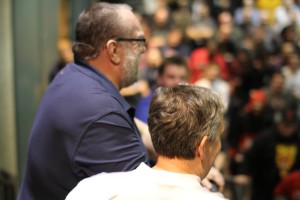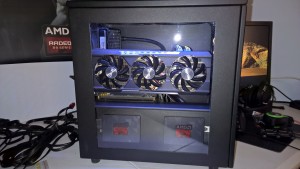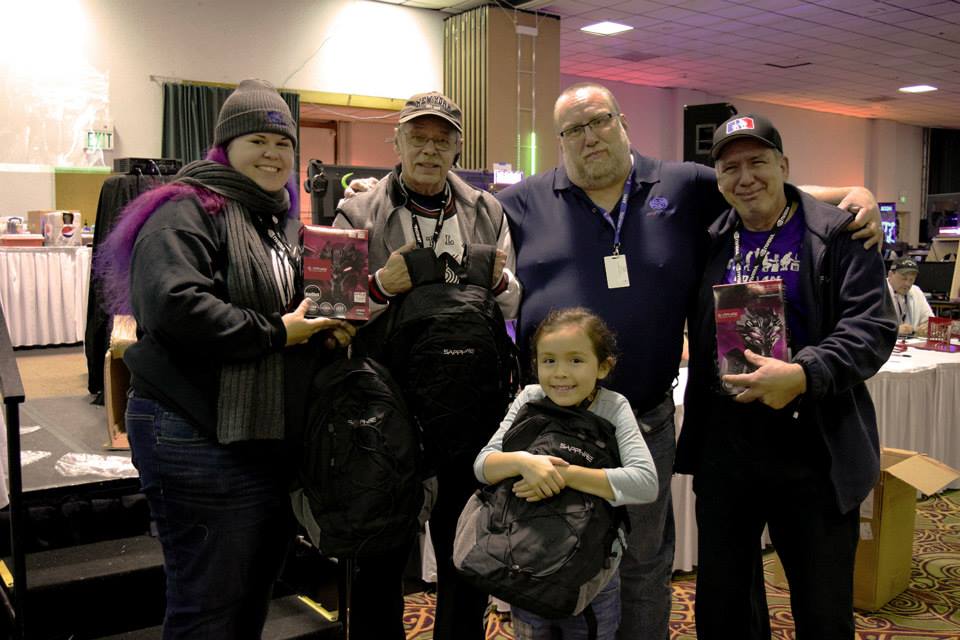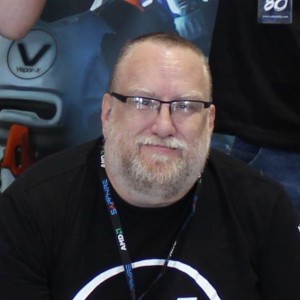Ramz had a great time over the course of two hours speaking to SAPPHIRE’s North American PR Edward Crisler about video games and technology. Here is how it went.
Q: So why don’t you give us an introduction about yourself.
A: I’m Edward “SAPPHIRE ED” Crisler. I’m the North American PR Representative, which is a fancy way of saying I’m the one who goes out and makes people understand why pc gamers should value SAPPHIRE products.
Q: We know you have had a radio show that stopped last year, how did you get to the radio business?
A: The radio show was a fluke; I was running tech support for a local ISP. One of the owners of the ISP happens to be at the time one of the biggest names in Talk Radio. “Pat Benton” approached me and wanted me to do a Christmas show about what you should buy your geek for Christmas, I was the biggest geek he knew. Two weeks later Pat approached me and said they wanted me back on the show, we picked a new geeky topic and the phone lines lit up with questions. Before I knew it I was a regular weekly guest. That went on for a few years before we had our own time slot. The show at its peak had about 100,000 listeners divided among real and internet radio.
Q: So from podcasting to SAPPHIRE’s North America PR manager. How did you acquire such a position?
A: The North American PR from SAPPHIRE had left the company and I had contacts with the Global PR Director, Bill Donnelly, trying to get a sample arranged for our radio show. He was telling me that the company is going through a reorganization and they needed somebody to take over North America and I was like “Shucks Bill I can do that job!”. I was joking of course – until a week later when I got a Skype call from him and he asked if I was serious about that. I replied in doubt that I had the needed qualification; I’m just a radio show host and a technology reviewer. “It is the reviewer background that is interesting,” Bill said – “just put a resume together and email to me. Couple of days later I get an email from Bill asking if I’m available for a Skype call in the next hour or so. An hour later Skype rings with Bill and some of SAPPHIRE management in a group call to interview me. The rest, as they say, is history.
Q: So as a SAPPHIRE PR what are your daily tasks?
A: Most PR guys know their products and can promote it. But I’m a serious video gamer. When I have free time I play video games and when I don’t have time I also play video games which gets me into trouble a lot. I do more than just sending out Press Releases, handing out video cards and marketing. I help with software trying to find glitches. I work with the reviewers and the customer base. Also I help with feedback to the product design teams and with marketing programs.
Q: Would you consider that your dream job?
A: Oh God, it is past being a dream. I get paid to play with new technology, video games, go to events and hang out with video gamers. I hope to retire from here.
Q: As the PR Representative how do you deal with the massive amount of review requests and on what bases do you choose the Reviewers?
A: Let me answer this openly. SAPPHIRE is a privately owned company with a global reach handled by a relatively small marketing team. So I get a limited number of cards to sample in North America. It forces me to be picky with the review requests that I deal with. I’ve to look at a great many criteria. When I talk to a reviewer I need to know that he will do something different. I was a reviewer for 20 years. I don’t limit the reviewer based on the size of their audience, I want a reviewer who will give me a chance to work with, to address any issues he might have found on a product. At the end of the day he can post his honest opinion about it.
As a former reviewer and one of the guys that was working to get companies to notice me, I understand the plight of the new reviewer looking to make his mark. I would love to help each of them but the simple truth is it is just not always possible.
Q: Why do you call yourself the “Gaming Evangelist”?
A: As I said before, I’m a PC gamer. I love playing video games and all I think about are the pc gamers. Yes I would love them to buy a SAPPHIRE card but I’m still all about PC gamers. It doesn’t matter if you run a $600 or a $100 graphics card. There is always a way to enjoy video games. People often get this wrong. Enthusiasts are people who pay thousands of dollars to build computers that they rarely use for gaming while PC gamers actually build a 600 to 800 dollar gaming PC and spend their time enjoying gaming at that PC. This is why I’m the Evangelist because I’m just all about PC gaming.
Q: You are known for being so vocal; does this get you in trouble or affect your position at SAPPHIRE?
A: I have a bad tendency to put my foot in my mouth; there are people at SAPPHIRE who cringe when I do what I do. In fact there is a joke between me and Bill that when he tells me that I can to talk to somebody about something, I ask how much leash I’m allowed to have. However being vocal is one of the reasons SAPPHIRE hired me. They wanted somebody who will be aggressive in the marketplace. One of the reputations I’ve built over the radio show and I’m proud of, is when people speak to me they know they will get the real me and my real opinion. I don’t want to be the typical Marketing/PR guy. I’m not a PC gamer by lip service, I’m a PC gamer at heart. At the end of the day does being vocal hurt me at SAPPHIRE? No. This is why they want me. I think it causes people to cringe as I’m not like anything corporate big wigs expect. I’m perfectly happy to have that role. It allows me to be me and I believe gamers respond to me better because I am being genuine.
Q: So in your opinion what differentiates SAPPHIRE from any other AMD board partner?
A: Innovation and attention to quality. SAPPHIRE has been the leader in the GPU card manufacturing community since it started.
Q: On the hardware front we’ve seen some harder core versions of the reference cards such as the Tri-X and the Vapor X – Will we be seeing these for the Fury X also?
A: SAPPHIRE’s Vapor-X, Tri-X and Dual-X were meant to be about the technology rather than being a brand. Vapor-X is a technology that has taken off to be a kind of a brand but we needed a simpler way for gamers to choose their card from SAPPHIRE’s huge range. That’s why we made the SAPPHIRE Nitro series to simplify card selection for pc gamers. Instead of picking among 20 different 380s for example you pick the SAPPHIRE Nitro as a brand, targeted for gamers, because the price is reasonable and the quality is there.
Cards in our SAPPHIRE Nitro series have high end features such as dual ball bearing fans, SAPPHIRE Black Diamond Chokes, high endurance solid capacitors and a stiffened PCB bracket for the shroud. So you get the equivalent of back plate stiffening without the added cost.
To answer your question about if we will do that with the Fury, we are not sure if we will do that with it or not yet.
Q: AMD has really been pushing a mainstream move to closed loop liquid coolers for GPUs. Will SAPPHIRE also be moving in this direction for non-reference cards or will you be sticking to air cooling?
A: SAPPHIRE has used them on high end models in the past. The problem with CLC is that it introduces a significant amount of added cost to the graphics card. We have worked really hard to make sure that our systems are efficient with air cooling as it can get. Remember we were the first to add a vapor chamber to graphics cards to achieve a better cooling solution on cards with high dissipation. It’s a tough call because the consumers want a reasonable price. But you can’t get everything at a reasonable price point. There is always a compromise to achieve what you want to achieve. It’s a tough choice. I won’t say we won’t do a CLC that is our own custom design. But from a consumer point of view there would be a price premium. In my opinion we don’t need a CLC just because our air cooled cards perform as good as it gets for the price point we are targeting.
Q: AMD gave up the VRAM lead over Nvidia to move on to newer technology “HBM” do you think that will hurt them?
A: Thing is with GDDR5 and HBM is that it’s quality vs. quantity. A lot of the Vram work is done in caching data and it has to be done because DDR5 has a narrower pipe line when it comes to moving the data around. Because the HBM pipeline is massive, it can move the data around faster without the need of a caching buffer to be on the card. Again benchmarks prove this out. Every time they pump up the resolution it keeps getting better. Look at the fury – it’s more of a proof of concept. Yes AMD shows it as their top tier card and it is. But it’s not all about that. It’s the way of AMD saying here is our concept and here we are proving it works. So I don’t think it will hurt AMD.
Q: Is it about the memory BUS speed or the amount of memory chips that makes HBM good?
A: it’s all about the bus speed. Video cards are about the parallelism to the extreme. Now to simplify this let me put it this way; you take a brush and start to paint your house, then a buddy comes over and picks a brush to paint another part. That would make it take you half the time- now what if you have 10 buddies helping you, what if you have 100 buddies helping you and you can position them to paint small independent sections without interfering with each other. The whole house will be painted in 10 minutes. We have been running our GPUs on 4 lanes and what HBM has done is expanding that to 16 lanes. Here is another example; we have been providing data through a garden hose, what HBM has done is it introduced the fire hose. If we maintained the speed of moving data the amount of data moved is so much bigger. That what makes HBM is so interesting, it actually has slower speed but it has got a ridiculous bus size that the speed is irrelevant. It can move so much data at one time.
Q: Rumors say that AMD will have earlier release of HBM Gen 2, what do you think about that?
A: It would make sense, I don’t have inside information about that, but the rumor is logical. Forget early access though, AMD has something no one else has. They have the experience building the interface. Nobody else has shown that they can make this work and AMD already has a card out and rocking the house. When they do this next time, they will take everything they learnt and come forward again. And this gives AMD a real lead on where this can go.
Q: So HBM is the future?
A: You have got to understand this. HBM and HBM Gen 2 and the upcoming HBM generations; they are not a fad, they are not something that is introduced to may or may not take off. They are here to stay. The future of all video card industry is heading this way, the console chips are heading this way. I can even speculate that future of CPU design will head this way.
Q: Don’t you think it’s hard to have a CPU with HBM. Different people will want the same CPU but with different amounts of RAM?
A: Again we are caught up in the enthusiast mindset, most people don’t upgrade their PCs, people buy their computers and keep it for 3 or 4 years they get rid of it and get another PC.
Q: But what about the convenience of just adding RAM?
A: Think about it, let’s take an i5 for 200$ and 8GB of ram for 60$ let’s say the cost is 275$, so let’s say you buy the same i5 with 8GB of HBM on it and that’s going to be a huge performance boost, so you are paying 10% more for 15 to 20% of all over performance boost. You will be have all this in a single package. That higher CPU price will reduce the motherboard cost, because now the motherboard manufacturers will not have to add ram slots. Also because HBM needs less power, motherboards will not have to use the same robust power management they do now. Forget CPUs for a second and think of APUs. We have seen performance gain in APUs every time you pump up the ram speed. AMD will benefit from this the most because their APUs will work better with HBM. Anything above 1600MHz with Intel makes slightly to no difference.
Q: Recently we have learnt that AMD is not collecting royalties for HBM. What do you think about that?
A: I wouldn’t be surprised; AMD has been the only one who has been as open as possible to giving the community what benefits the community. AMD has openly handed mantle to OpenCL to make Vulkan, AMD has worked hand in hand with Microsoft to make DirectX12 get off the ground. AMD took Adaptive Sync and went and pushed for an open standard that anybody can use, and they won’t make licensing off that. For AMD to not take licensing from other companies making use of HBM then doesn’t surprise me. For me the sad part is why aren’t pc gamers screaming and yelling about this and praising AMD instead of defending the other side!
Q: How do you feel about the Nvidia DX 12 support issues?
A: To me it’s a mountain made out of a mole hill, we shouldn’t be focusing on what other companies do, we should focus on making what we have better.
Q: How do you feel about Nvidia’s GameWorks?
A: I don’t mind companies helping with game development as long as there is no proprietary code involved. Let’s take the newest API for example, just make sure that the game is DirectX 12 compliant. Make sure the game hits every mark in DirectX 12 and let GPU manufactures worry about their chips and their drivers.
Q: Don’t you think AMD should get more involved with Game developers. There are not a whole lot of AMD AAA huge titles out there?
A: AMD is involved in a lot of game development, but they don’t have huge amount of money to invest into game companies, Nvidia will tell you they don’t sink money to game companies and that’s half the truth. Although Nvidia is claiming that they don’t give money outright to developers; I believe what’s happening is that they are paying engineers to go to game development and go sit there for two weeks working with the guys, their engineers are sitting there writing code and giving it to the guys. They are providing companies with code that would take these companies money to get done. They are giving so much material that would translate to money for game developers.
For me, and I’m taking off my SAPPHIRE hat here. I want video games developers to work on their own games without any other party helping them. I want the unbiased experience and let video card manufactures worry about their GPUs and Driver optimization.
Q: SAPPHIRE Nation. Who is behind the idea and what are the goals and dreams behind it?
A: SAPPHIRE’s marketing team is behind the idea, and the philosophy of it is that we don’t see many
companies approaching gamers. Like you might be in a  gaming event and see not a single gaming related topic or show. Basically SAPPHIRE nation is focusing on gamers. We don’t care what your hardware is we don’t care if you use Nvidia, AMD. We just care about the gamers. We would be happy if it was SAPPHIRE but it’s just a gamer based community. If you go to SAPPHIRE Nation’s site you will find topics about anything gaming related. The idea is that it is a community site where games can see different opinions voiced about general issues as well as being a hub for some of SAPPHIRE’s social media content.
gaming event and see not a single gaming related topic or show. Basically SAPPHIRE nation is focusing on gamers. We don’t care what your hardware is we don’t care if you use Nvidia, AMD. We just care about the gamers. We would be happy if it was SAPPHIRE but it’s just a gamer based community. If you go to SAPPHIRE Nation’s site you will find topics about anything gaming related. The idea is that it is a community site where games can see different opinions voiced about general issues as well as being a hub for some of SAPPHIRE’s social media content.
Q: What do you think about FreeSync? Do you use it yourself?
A: First of all I’m using it. I have to say I was skeptical about the technology thinking it would add nothing. You could always overcome stuttering by staying under the monitor’s frequencies. Then tearing was negligible. Until I tried one, I said to myself that I’ll give it a week and on the first day of using it I decided I was wrong all along. It is great. Either FreeSync or Gsync, the idea of adaptive sync is just great. The smoothness you find in gameplay can’t be unseen. If you are not using it you won’t know. But once you start using it you will never go back. Look at the curved monitors for example. People who don’t use them won’t know how great they are. But once you do if you are back to a flat monitor you will notice the difference. Those curves just aren’t there anymore.
Q: You are a gamer at heart, And LAN addicted as far as I know. What is your favorite LAN event and why?
A: Oh can I have 3?
Sure why not
- Catacombz: is my hometown LAN in southern Illinois, it’s a lot of fun for a bunch of people to meet locally and play video games for the weekend. It’s about 120 – 130 people. A lot of the people at the event are guys I know from my home town, people that I’ve worked with. People go there with their families for the weekend to play video games. These are guys I don’t just see at every LAN event – these are guys I see a couple of times a week.
- LAN OC: is a small event in Ohio, it has been going since 2007. “Wes” runs an amazing event, he takes a 130 person LAN event and makes it feel bigger but not in the bad way of bigger events, it’s fun, it’s exciting. Many of the people who attend this event have become family to me and my wife and my son. It’s a family vacation for us. We pull our son from school for a day and we head there. It’s a 6 hour drive. We go out there and play video games there as a family for the weekend.
- PDX LAN: PDX is one of the biggest independent LANS in North America. 500 to 550 people attend this LAN. It’s a tech enthusiast and modders heaven. This is where you will see the cream of the crop when it comes to pc modding. These guys are amazing. “Matt Conwell” and his wife run this event. And what they do is that they take this large of an event and have that same family feel of smaller events. The first hour or two hours of door opening is me shaking hands and hugging people. Saying hi to people I’ve talked to all year on Facebook or twitter. There are gaming groups and individuals there that I seriously count as friends. It’s a wonderful community and it’s a lot of fun to go there and meet people and spend time with them.
Q: So basically your favorite LAN events are about that family atmosphere you get?

A: Yes it is. It’s all about the people. People think it’s all about games, and they are there, but it’s the people who make it different. Like last PDX LAN I went out there and played dodge ball. And here is something for your readers. I encourage every pc gamer out there to go find one event even if it is across the country, take the flight, take the drive, take the adventure. Take the two days and go join one of these communities. They take the gaming experience to a whole new level. And I can’t explain to people how it feels when you find that one LAN event that grabs you and you want to go to. It’s just an incredible experience that you will look forward to.
Q: What hardware do you drag along to LAN events?
A: I run an Intel i7 4790k, 16Gigs of ram, An SSD supplied by AMD and a SAPPHIRE Nitro R 9 390 in CaseLabs Mercury S3. The kind folks at BeQuiet provided the PSU and case fans.
Q: Is that your main rig or you have another personal rig?
A: I have a personal desktop and it has the same components except I run a SAPPHIRE R9 Tri-X Fury in it and it’s in a Fractal Design Arc Mini.
Q: What are your favorite games currently?
A: I play a lot MechWarrior Online, Garden Warfare, Elder Scrolls Online and Insurgency. I’m not a big FPS fan. But for me I love getting 4 or 5 people and play Insurgency in co-op mode.
Q: So what are your favorite games of all time?
A: I can give you a couple; Starfleet command 2, Skyrim and MechWarrior 4 mercenaries.
Q: Any upcoming games you are excited for?
A: Garden Warfare 2, Hitman looks interesting, Fallout 4 and being Bethesda you know it’ll be mediocre game and the modders will fix it. I want to get excited about Dishonored 2 but I’m afraid they will screw it.
Q: What is with companies that take franchises and screw them up over and over again?
A: This is frustrating because they just take the cheap remixes. Then Ed asked me what 3 games I would love to see remade – I answered:
The original Max Payne, Ninja Gaiden for PC and Doom being made as the classic it was and Ed agreed with the first and the later one, so I asked him the same question:
A: Wing Commander properly remade, MechCommander and Birth of the Federation and another one I would love see being remade is Battlefield 1942.
Q: Where is Ruby?
A: I don’t know myself. That girl on our SAPPHIRE cards wasn’t Ruby by the way. Ruby was AMD’s own character. Our last girl, like the earlier ones, was developed specially for us and posed and clothed by our Creative Director. The reason we did change to the robot series was because the robot speaks “technology” and that’s the message we are trying to deliver to our customers. What speaks about technology more than a robot and that’s what you get when you buy a SAPPHIRE card. We invest in technology. And I don’t think there is a gamer on earth that won’t like a super bad ass robot.
A big thanks to Ed for doing this interview it’s been an amazing conversation and we hope to see him again in the future.
You can follow Ed at:
Twitter: SAPPHIREEd
Facebook: edward.crisler












